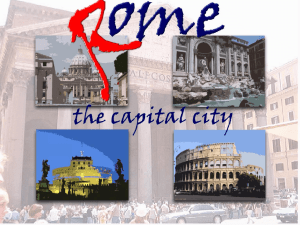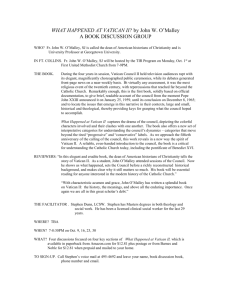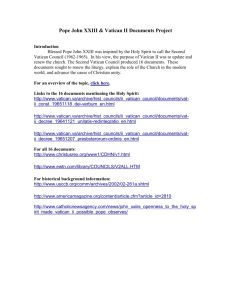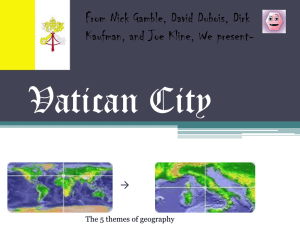here - myndrs.com
advertisement
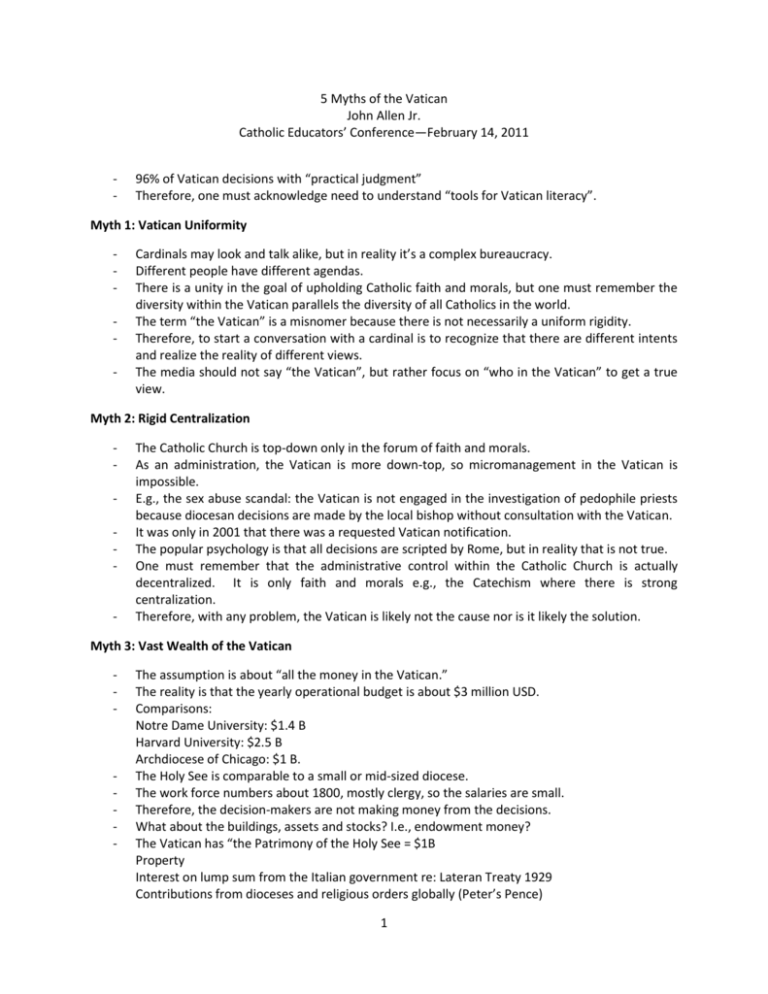
5 Myths of the Vatican John Allen Jr. Catholic Educators’ Conference—February 14, 2011 - 96% of Vatican decisions with “practical judgment” Therefore, one must acknowledge need to understand “tools for Vatican literacy”. Myth 1: Vatican Uniformity - Cardinals may look and talk alike, but in reality it’s a complex bureaucracy. Different people have different agendas. There is a unity in the goal of upholding Catholic faith and morals, but one must remember the diversity within the Vatican parallels the diversity of all Catholics in the world. The term “the Vatican” is a misnomer because there is not necessarily a uniform rigidity. Therefore, to start a conversation with a cardinal is to recognize that there are different intents and realize the reality of different views. The media should not say “the Vatican”, but rather focus on “who in the Vatican” to get a true view. Myth 2: Rigid Centralization - - The Catholic Church is top-down only in the forum of faith and morals. As an administration, the Vatican is more down-top, so micromanagement in the Vatican is impossible. E.g., the sex abuse scandal: the Vatican is not engaged in the investigation of pedophile priests because diocesan decisions are made by the local bishop without consultation with the Vatican. It was only in 2001 that there was a requested Vatican notification. The popular psychology is that all decisions are scripted by Rome, but in reality that is not true. One must remember that the administrative control within the Catholic Church is actually decentralized. It is only faith and morals e.g., the Catechism where there is strong centralization. Therefore, with any problem, the Vatican is likely not the cause nor is it likely the solution. Myth 3: Vast Wealth of the Vatican - - The assumption is about “all the money in the Vatican.” The reality is that the yearly operational budget is about $3 million USD. Comparisons: Notre Dame University: $1.4 B Harvard University: $2.5 B Archdiocese of Chicago: $1 B. The Holy See is comparable to a small or mid-sized diocese. The work force numbers about 1800, mostly clergy, so the salaries are small. Therefore, the decision-makers are not making money from the decisions. What about the buildings, assets and stocks? I.e., endowment money? The Vatican has “the Patrimony of the Holy See = $1B Property Interest on lump sum from the Italian government re: Lateran Treaty 1929 Contributions from dioceses and religious orders globally (Peter’s Pence) 1 - Cf. endowment of Notre Dame University = $ 30 B & Harvard University ($100 B) What about the art and museums? It’s literally priceless Value of Pieta is 1 Euro because it can never be sold or borrowed against according to the rules i.e., Artistic Patrimony All funds from entrance fees to the Vatican Museum go to maintainance Myth 4: Vatican Secrecy - - - - Rome is a city where everything is a mystery but nothing is a secret. No one is good at keeping secrets even if they try. e.g., a papal document is often leaked and debated 95% of cases, most issues are transparent The real problem of the Vatican is not secrecy but singularity because it is very unique i.e., no other institution operates like the Vatican. e.g., Dominus Jesus: Catholicism v. other religions “Obviously speaking, non-Christians are in grave deficiency in salvation” is Ratzinger’s note in the differences between Dominican and Jesuit views on grace. The Vatican is its own institution compared to others One must know Italian One must know Latin, Liturgy, Canon Law, Theology, Philosophy One must the language of Vatican workings Dicasteries = collectives of different offices in the Vatican Congregations = decision makers Council = think tank One must acknowledge that the Vatican is unique culturally. The Vatican, in turn, should have a better knowledge of the outside world. With this knowledge, once it is better understood, the Vatican is actually rather transparent, especially compared to the Pentagon or even General Motors. Therefore why does the whole myth of secrecy exist? It’s a secret of Journalism: if the Vatican seems secret, the reporter can have some kind of excuse for not understanding, but if the Vatican seems transparent, the reporter is at fault for not understanding. Myth 5: Careerism - The idea is that everyone in the Vatican is there to advance in an ecclesiastical career i.e., monsignor to bishop to pope. Careerism does exist just like in all professions, but this is the weakest way to explain the goingson in the Vatican. Remember, if one looks at every cleric working in the Vatican that had a minimum one year in the US, only 32% of them became bishops. No one applies for a Vatican job; instead it is usually a letter sent to a cleric asking under obligation of obedience to work in the Vatican. The idea that all cardinals want to be pope is not true (based on Allen’s personal interviews). 2005 Conclave: majority of 115 cardinals did not want the job; why? 1. Cardinals are true believers and believe that the Pope is the Successor of St. Peter, and therefore understand their own weaknesses compared to the papal ideal. 2 - 2. Retired cardinals have a good deal; they get to give insight on documents, they get the “best tables” in restaurants, they are allowed to write memoirs or give lectures i.e., freedom to do what they want and the time to do it. > Compare this to the papacy, which is a life sentence with great responsibility as a CEO, rockstar, saint, political expert, to theologian (cf. athletic Cardinal Wojtyla to frail John Paul II) Therefore, there is some jockeying for the papacy, but it is not in the mainstream. Conclusion - Debunking these myths in not to be an excuse for or criticism of Vatican handling of certain issues. The value of debunking these myths is that it clears the air and avoids distractions in discussing the issues. Remember that these are ordinary men doing their best, so there is more production in discussing issues as opposed to wasting time with myths. Engagement with the Vatican is possible, but one must do one’s homework and go for the long term. The allegory: the US political system is a microwave, but the Vatican is a slow-cooker/crockpot. Disagreement does not necessarily mean division; cf. Cardinal Medina (traditionalist) vs. Cardinal Marini (progressive) over the canonization of St. Juan Diego The Vatican’s problem is that it is not skilled in telling its story i.e., bad PR [my note: cf. Philip II of Spain] 3
